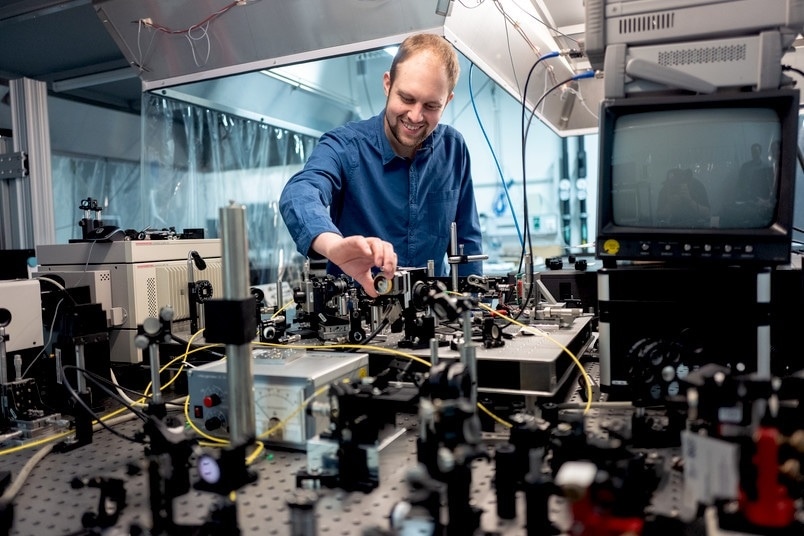Apr 5 2019
Engineers at Ruhr-Universität Bochum have created a unique concept for fast data transfer via optical fiber cables. In present-day systems, a laser conveys light signals via the cables and information is coded in the variety of light intensity. In contrast, the new system, a semiconductor spin laser, is founded on a modulation of light polarization. Published on April 3rd in the journal “Nature”, the study shows that spin lasers have the capacity of functioning at least five times as quickly as the best traditional systems, while using up just a fraction of energy. Unlike other spin-based semiconductor systems, the technology potentially functions at room temperature and does not require any outer magnetic fields. The Bochum team at the Chair of Photonics and Terahertz Technology executed the system in partnership with colleagues from Ulm University and the University at Buffalo.
 Markus Lindemann is working on the development of ultrafast spin lasers as part of his doctoral thesis. (Image credit: © RUB, Kramer)
Markus Lindemann is working on the development of ultrafast spin lasers as part of his doctoral thesis. (Image credit: © RUB, Kramer)
Rapid data transfer is currently an energy guzzler
As a result of physical restrictions, data transfer that is founded on a modulation of light intensity without utilizing intricate modulation layouts can only reach frequencies of about 40 to 50 gigahertz. So as to realize this speed, high electrical currents are required. “It’s a bit like a Porsche where fuel consumption dramatically increases if the car is driven fast,” compares Professor Martin Hofmann, one of the engineers from Bochum. “Unless we upgrade the technology soon, data transfer and the Internet are going to consume more energy than we are currently producing on Earth.” Along with Dr. Nils Gerhardt and PhD student Markus Lindemann, Martin Hofmann is, thus, exploring alternative technologies.
Circularly polarized light as information carrier
Offered by Ulm University, the lasers, which are merely a few micrometers in size, were used by the scientists to produce a light wave whose oscillation direction changes intermittently in a particular way. The outcome is circularly polarized light that is created when two linear perpendicularly polarized light waves overlap.
Oscillating circular polarization
In linear polarization, the vector illustrating the light wave’s electric field oscillates in a fixed plane. In circular polarization, the vector rotates around the direction of propagation. The trick: when two linearly polarized light waves have various frequencies, the process results in oscillating circular polarization where the oscillation direction reverses occasionally – at a user-defined frequency of more than 200 gigahertz.
Speed limit as yet undetermined
We have experimentally demonstrated that oscillation at 200 gigahertz is possible. But we don’t know how much faster it can become, as we haven’t found a theoretical limit yet.
Martin Hofmann, Professor, Ruhr-Universität Bochum.
Only the oscillation does not convey any information; for this purpose, the polarization has to be moderated, for instance, by removing individual peaks. Hofmann, Gerhardt, and Lindemann have confirmed in experiments that this can be achieved in principle. In partnership with the team of Professor Igor Žutić and PhD student Gaofeng Xu from the University at Buffalo, they used numerical simulations to show that it is hypothetically possible to modulate the polarization and, consequently, the data transfer at a frequency of over 200 gigahertz.
The generation of a modulated circular polarization
Two factors are conclusive so as to produce a modulated circular polarization degree: the laser has to be worked in a way that it releases two perpendicular linearly polarized light waves concurrently, the overlap of which leads to circular polarization. Furthermore, the frequencies of the two emitted light waves have to vary sufficiently to enable high-speed oscillation.
The laser light is produced in a semiconductor crystal, which is inserted with electrons and electron holes. When they meet, light particles are emitted. The spin – an intrinsic form of angular momentum – of the injected electrons is necessary so as to guarantee the precise polarization of light. Only if the electron spin is aligned in a particular way, the emitted light has the necessary polarization – a challenge for the scientists, as spin alignment varies rapidly. This is why the scientists have to inject the electrons as meticulously as possible to the spot within the laser where the light particle is to be released. Hofmann’s team has already applied for a patent with their concept of how this can be realized using a ferromagnetic material.
Frequency difference through double refraction
The frequency variance in the two emitted light waves that is necessary for oscillation is produced using a technology given by the Ulm-based team headed by Professor Rainer Michalzik. The semiconductor crystal used for this purpose is said to be birefringent. So, the refractive indices in the two perpendicularly polarized light waves released by the crystal vary marginally. Therefore, the waves have diverse frequencies. By bending the semiconductor crystal, the scientists could modify the difference between the refractive indices and, accordingly, the frequency difference. That difference defines the oscillation speed, which may ultimately become the basis of accelerated data transfer.
The system is not ready for application yet. The technology has still to be optimised. By demonstrating the potential of spin lasers, we wish to open up a new area of research.
Martin Hofmann, Professor, Ruhr-Universität Bochum.